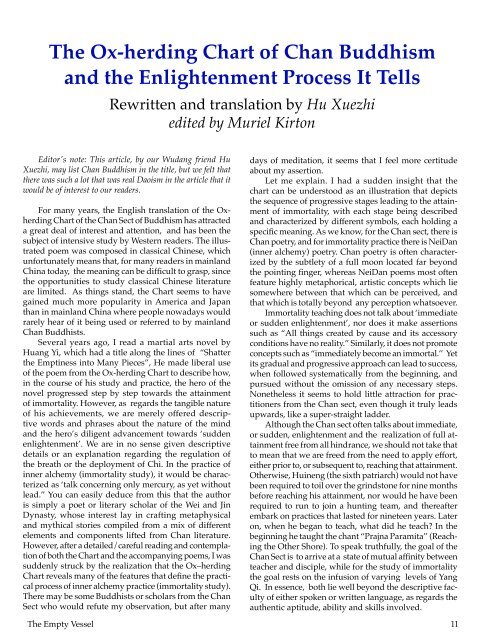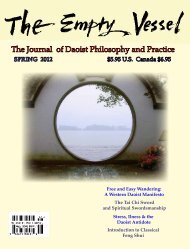Free Sample issue of The Empty Vessel - CommunityAwake
Free Sample issue of The Empty Vessel - CommunityAwake
Free Sample issue of The Empty Vessel - CommunityAwake
- No tags were found...
Create successful ePaper yourself
Turn your PDF publications into a flip-book with our unique Google optimized e-Paper software.
<strong>The</strong> Ox-herding Chart <strong>of</strong> Chan Buddhismand the Enlightenment Process It TellsRewritten and translation by Hu Xuezhiedited by Muriel KirtonEditor's note: This article, by our Wudang friend HuXuezhi, may list Chan Buddhism in the title, but we felt thatthere was such a lot that was real Daoism in the article that itwould be <strong>of</strong> interest to our readers.For many years, the English translation <strong>of</strong> the OxherdingChart <strong>of</strong> the Chan Sect <strong>of</strong> Buddhism has attracteda great deal <strong>of</strong> interest and attention, and has been thesubject <strong>of</strong> intensive study by Western readers. <strong>The</strong> illustratedpoem was composed in classical Chinese, whichunfortunately means that, for many readers in mainlandChina today, the meaning can be difficult to grasp, sincethe opportunities to study classical Chinese literatureare limited. As things stand, the Chart seems to havegained much more popularity in America and Japanthan in mainland China where people nowadays wouldrarely hear <strong>of</strong> it being used or referred to by mainlandChan Buddhists.Several years ago, I read a martial arts novel byHuang Yi, which had a title along the lines <strong>of</strong> “Shatterthe Emptiness into Many Pieces”, He made liberal use<strong>of</strong> the poem from the Ox-herding Chart to describe how,in the course <strong>of</strong> his study and practice, the hero <strong>of</strong> thenovel progressed step by step towards the attainment<strong>of</strong> immortality. However, as regards the tangible nature<strong>of</strong> his achievements, we are merely <strong>of</strong>fered descriptivewords and phrases about the nature <strong>of</strong> the mindand the hero’s diligent advancement towards ‘suddenenlightenment’. We are in no sense given descriptivedetails or an explanation regarding the regulation <strong>of</strong>the breath or the deployment <strong>of</strong> Chi. In the practice <strong>of</strong>inner alchemy (immortality study), it would be characterizedas ‘talk concerning only mercury, as yet withoutlead.” You can easily deduce from this that the authoris simply a poet or literary scholar <strong>of</strong> the Wei and JinDynasty, whose interest lay in crafting metaphysicaland mythical stories compiled from a mix <strong>of</strong> differentelements and components lifted from Chan literature.However, after a detailed/careful reading and contemplation<strong>of</strong> both the Chart and the accompanying poems, I wassuddenly struck by the realization that the Ox–herdingChart reveals many <strong>of</strong> the features that define the practicalprocess <strong>of</strong> inner alchemy practice (immortality study).<strong>The</strong>re may be some Buddhists or scholars from the ChanSect who would refute my observation, but after manydays <strong>of</strong> meditation, it seems that I feel more certitudeabout my assertion.Let me explain. I had a sudden insight that thechart can be understood as an illustration that depictsthe sequence <strong>of</strong> progressive stages leading to the attainment<strong>of</strong> immortality, with each stage being describedand characterized by different symbols, each holding aspecific meaning. As we know, for the Chan sect, there isChan poetry, and for immortality practice there is NeiDan(inner alchemy) poetry. Chan poetry is <strong>of</strong>ten characterizedby the subtlety <strong>of</strong> a full moon located far beyondthe pointing finger, whereas NeiDan poems most <strong>of</strong>tenfeature highly metaphorical, artistic concepts which liesomewhere between that which can be perceived, andthat which is totally beyond any perception whatsoever.Immortality teaching does not talk about ‘immediateor sudden enlightenment’, nor does it make assertionssuch as “All things created by cause and its accessoryconditions have no reality.” Similarly, it does not promoteconcepts such as “immediately become an immortal.’’ Yetits gradual and progressive approach can lead to success,when followed systematically from the beginning, andpursued without the omission <strong>of</strong> any necessary steps.Nonetheless it seems to hold little attraction for practitionersfrom the Chan sect, even though it truly leadsupwards, like a super-straight ladder.Although the Chan sect <strong>of</strong>ten talks about immediate,or sudden, enlightenment and the realization <strong>of</strong> full attainmentfree from all hindrance, we should not take thatto mean that we are freed from the need to apply effort,either prior to, or subsequent to, reaching that attainment.Otherwise, Huineng (the sixth patriarch) would not havebeen required to toil over the grindstone for nine monthsbefore reaching his attainment, nor would he have beenrequired to run to join a hunting team, and thereafterembark on practices that lasted for nineteen years. Lateron, when he began to teach, what did he teach? In thebeginning he taught the chant “Prajna Paramita’’ (Reachingthe Other Shore). To speak truthfully, the goal <strong>of</strong> theChan Sect is to arrive at a state <strong>of</strong> mutual affinity betweenteacher and disciple, while for the study <strong>of</strong> immortalitythe goal rests on the infusion <strong>of</strong> varying levels <strong>of</strong> YangQi. In essence, both lie well beyond the descriptive faculty<strong>of</strong> either spoken or written language, as regards theauthentic aptitude, ability and skills involved.<strong>The</strong> <strong>Empty</strong> <strong>Vessel</strong> 11








